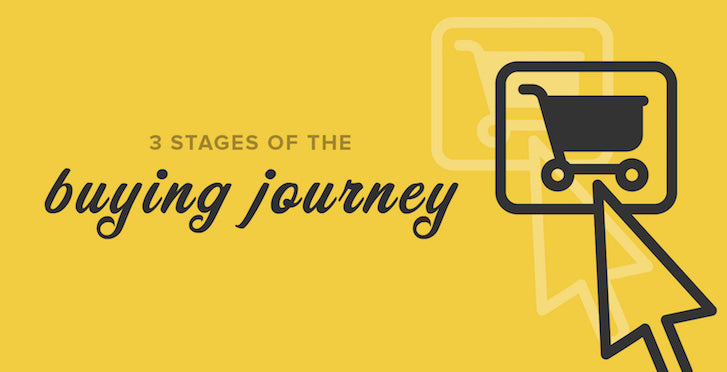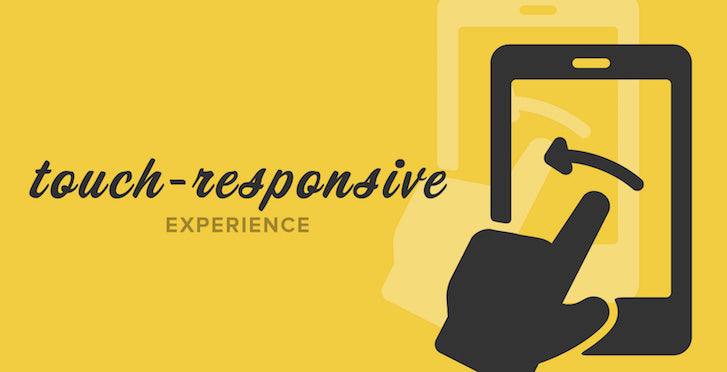As the last remnants of winter melt away, spring brings a whole new season of fashion trends, recreation opportunities, and a desire to get back outside. This month we focus on strategies and tactics that can inform both the on-site user experience, as well as content used to appeal to customers.
The first strategy outlined below, regarding the 'buying journey', is something we've found particularly helpful in working with our clients, and in helping determine what is and what isn't essential on their website.
You might also like: The Seven Deadly Sins of User Experience Design
1. Catering to the three steps in the buying journey
 When designing an ecommerce website, many designers take into consideration the different target audiences their clients might have. Although the typical means of differentiating your users based on demographics can be helpful, another perspective to take is to differentiate users by which stage in the buying journey they're in.
When designing an ecommerce website, many designers take into consideration the different target audiences their clients might have. Although the typical means of differentiating your users based on demographics can be helpful, another perspective to take is to differentiate users by which stage in the buying journey they're in.
To keep things simple, you can think of the buying journey in three main stages: inspiration, information, and intention. Let's say your client is a retailer who sells a variety of clothing from a few different brands on their website. Below, we’ll examine how each of these three personas might require a different user experience.
The inspiration stage
Customers in the inspiration stage, which we sometimes also refer to as discoverers, are early in the buying process and are coming to your client’s website more out of curiosity than for a specific reason.
In our aforementioned example, this might include someone who loves fashion but does not have any particular product in mind that they currently need. This customer is likely to arrive on-site via a blog article, or through social content from an influencer in the fashion industry, given that they are likely to keep up with general trends.
Since they're on your client’s website to explore, we need to tailor their user experience around elements that will inspire them to take action down the line. This type of experience could be driven by editorial content such as lookbooks, blog articles, buying guides, curated collections, and any other story-driven method of showcasing products.
In terms of the conversion goal for those in the inspiration stage, you might find more success focusing on secondary goals, such as getting them to follow you on social media or joining your mailing list. This will give you the opportunity to capture these leads in your client’s marketing funnel and continue to nurture them until they are ready to make a specific purchase.
The information stage
Those in the information stage, which we can be referred to as browsers, are in the middle of their buying process and are coming to your client’s website to see what product options you have for a given buying criteria.
This might be someone who knows they need a new jacket, but are not entirely sure of the style, label, or color they want yet. They're likely to arrive on-site after reading content about recent trends, or while searching for brands they like in Google. Given the right product and offer, there is a chance that they could make a purchase when they arrive at your client’s site, but they're more likely to be searching for different product options and general information about your company.
Since they're looking to be educated, we need to tailor their user experience around elements that will help them find the right product for them. This type of experience could be driven by product browsing features such as filtering, sorting, and comparison tools, or by educating them on your shipping policies, return policies, and promotions.
In terms of the conversion goal for those in the information stage, you certainly want to push them towards a purchase, but you might want to also focus on getting them to simply add a product to a wish list, share it with a friend for feedback, or join your mailing list in exchange for a discount code. This will give you the opportunity to start building a profile around this user and utilize follow-up marketing tactics, such as retargeting ads or email campaigns to push them along the funnel.
The intention stage
Those in the intention stage, which we sometimes refer to as searchers, are at the end of their buying process and are coming to your client’s website to make a final purchasing decision.
This might be someone who knows they want a medium, black, canvas jacket for example. They're likely to arrive on-site because they searched for that product specifically in Google, or saw a retargeting ad of yours after visiting your client’s website in the past. Their goal is to be confident in their buying decision and to pull the trigger on the purchase.
Since they're looking to take an action, we need to tailor their experience towards getting them to the right product as quickly as possible. This type of experience could be driven by advanced search tools, making it easy for them to find the right product, and helping remove any 'barriers' to making a purchase decision, such as try-on-at-home options, clear return policies, bulk purchase discounts, first time customer incentives, and loyalty programs.
In terms of the conversion goal for those in the intention stage, it's all about the sale. Should that sale not go through, the second thing to focus on is abandoned cart management and continuing to incentivize the customer to make that purchase.
You might also like: 8 Things My Mom Taught Me About UX
2. Adding social proof
 Humans are social creatures by nature. We love interacting with other people and often many of our beliefs, tastes, and decisions are based on the influence of others. In the world of ecommerce, this resonates in a strategy referred to as 'social proof'.
Humans are social creatures by nature. We love interacting with other people and often many of our beliefs, tastes, and decisions are based on the influence of others. In the world of ecommerce, this resonates in a strategy referred to as 'social proof'.
The idea of social proof is that consumers are more likely to make a purchasing decision when they see other people making that same purchase or believing in that same brand. When designing a website, there are a number of specific tactics that can be explored to lay down the groundwork of social proof.
Reviews and coverage
One of the most common methods for creating social proof in ecommerce is the use of product reviews and testimonials. This could be in the form of traditional five star rankings, quotes from customers, or reviews sourced from third-party websites.
The overall goal is to build trust with the customer by showcasing how many other people have trusted the product or brand in the past. Tools such as YOTPO make adding these sorts of reviews easy. Another spin on this would be to showcase press coverage or awards received. They're similar, in a way, to product reviews, but are simply coming from more authoritative sources, lending even more credibility to their claims.
User generated content
In addition to reviews and coverage, incorporating other forms of customer-generated content can be highly effective for creating social proof. This might include personal anecdotes, or visual media submitted by customers that are showcased in a blog or dedicated section of the website. It could also include social media content contributed by customers, such as brand mentions on Twitter or Youtube.
One of my favorite forms of user-generated content includes customer-submitted photos of themselves with a product or brand, posted on Facebook or Instagram. Including this sort of content on specific and related product pages can provide a strong context of social proof while someone is evaluating a product. Platforms such as Olapic, TagTray, and Candid make this sort of functionality easy to implement on a website.
3. Creating a touch-responsive experience
 With mobile traffic now representing 50% of site visitors for most ecommerce stores, there is no doubt that having a mobile responsive website is essential. Many ecommerce brands, however, only skim the basics of possibilities when it comes to that experience.
With mobile traffic now representing 50% of site visitors for most ecommerce stores, there is no doubt that having a mobile responsive website is essential. Many ecommerce brands, however, only skim the basics of possibilities when it comes to that experience.
Resizing images, collapsing navigation, and stacking content are all best practices that should be utilized, but responsive design does not have to stop there. We've begun experimenting with a few touch-responsive design tactics that seem to be working well for our clients.
Navigation
When it comes to navigation, most designers default to collapsed menus. These work great on mobile devices, but might leave the experience for tablet users feeling a bit lackluster. If you're interested in maintaining an expanded navigation on larger mobile and tablet devices, it's important to give thought to how dropdowns might function.
Osvaldas Valutis has a great article on creating touch-friendly drop-down navigation that addresses the issue of having to double click links while on tablet devices.
Sliders
Large banners with high resolution imagery are still quite prominent in the world of ecommerce design, especially on many fashion websites. For mobile and tablet users, those banners can become increasingly more interesting by enabling 'touch' functionality. This functionality allows users to easily swipe back-and-forth from one slider to the next.
Extending this interaction beyond the ominous homepage slider, you could apply the same concept to navigating products, blog posts, and much more. A great option for adding this functionality is Swiper, a free and modern mobile touch slider with hardware accelerated transitions and amazing native behavior.
Layers
With limited screen space on mobile, it's important to get creative with how content is displayed. Rather than just thinking vertically or horizontally, expand your canvas by adding depth and use layers to add/manage additional content on a page.
An increasingly common practice is to use sliding navigation and carts that pull from the left and right of the screen. These elements sit on top of the website as another layer that can slide in as the user swipes.
Web Designer Depot has a great tutorial on adding mobile style slide-in navigation, which can be repurposed for the same effect with a cart.
These are just a few ways to improve user experiences in your ecommerce designs. What strategies do you use? Tell us in the comments section below.
Read more
- What to Consider When Planning a Website Redesign
- Content Strategy: The Principles we Followed to Build the New Shopify App CLI
- The Pivotal Role of User Experience Design in Brand Building
- The Case for Continual Development: The New Way to Approach Ecommerce
- 10 Ways to Improve User Engagement for Your App This Valentine's Day
- The Top 4 Reasons Users Abandon Their Carts and What to Do About it
- What Makes or Breaks an Ecommerce Shopping Experience? This Survey has the Answers
- Microinteractions: Tiny Design Decisions, Big User Impact
- 3 High-Impact Tips for Designing an Ecommerce Site That Converts
You might also like: 10 Things I Learned About UX By Being Drunk

